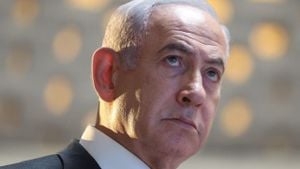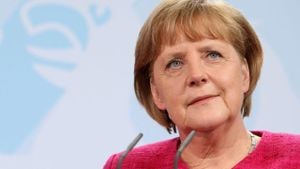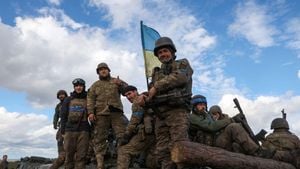Taiwan stands at a crossroads, grappling with its security amid rising military aggression from China. The tension between Taipei and Beijing has escalated sharply, sparking discussions on innovative defense strategies to safeguard the island nation. With China relentlessly advancing its military capabilities, Taiwan’s response hinges on adapting its approach to defense through asymmetric warfare and bolstered cyber capabilities.
The so-called ‘porcupine strategy’ is central to Taiwan's new defense posture. This approach encourages maximizing deterrence by making any potential invasion costly for China. Drawing lessons from conflicts, including the recent war in Ukraine, Taiwan's leadership is increasingly focused on how it can fend off threats posed by the People's Liberation Army (PLA). The idea here is to utilize smaller, more agile forces rather than focusing exclusively on traditional, large-scale military units.
President Lai Ching-te’s government has emphasized these asymmetric capabilities, reinforcing the need for reforms within Taiwan’s military framework. Already, significant strides have been made since former President Tsai Ing-wen took office. Under her leadership, Taiwan initiated comprehensive transformations within its defense policies, including increased spending and the reinstatement of compulsory military service.
These changes weren't merely about numbers. They also included reimagining military strategy to embrace what analysts label 'asymmetric warfare'. The goal is to optimize Taiwan’s defense structures to withstand or even repel initial attacks launched by larger forces—much like the spiky defenses of a porcupine threatening larger predators. At the heart of this strategy is the intention to deny aggressors the opportunity to launch invasions with ease, thereby recalibring the threat calculus for China.
Despite these ambitious objectives, skepticism remains high among military personnel about the efficacy of asymmetric strategies. Many within Taiwan's armed forces are traditionally conditioned to believe more conventional approaches are superior. The challenge lies not only in changing tactics but also shifting the ingrained military culture and structure, which has favored large and expensive military assets over more innovative, compact defense systems.
The recent rise of PLA incursions has only deepened the urgency of Taiwan’s defense reforms. Just as Xi Jinping reiterated the “historically inevitable” unification of Taiwan and China, the frequent violations of Taiwan's airspace and maritime boundaries by Chinese military forces have become commonplace, marking increasingly aggressive posturing from Beijing. Indeed, the Taiwanese government has noted the frequency of these incursions has surged, with multiple aircraft breaching Taiwan's air defense identification zone (ADIZ) on several occasions.
This growing pressure has prompted Taiwan to adopt proactive measures. Drawing parallels to Ukraine’s methods of defense against the Kremlin’s invasion, Taiwan is eyeing establishing its own 'IT Army'—a group collaborating voluntarily on cyber efforts to prepare for potential conflicts. The premise is simple yet powerful: to leverage technology and recruit skilled individuals able to launch coordinated cyber operations to cripple enemy capabilities.
Taiwan's ambitions are bolstered by Ukraine's cyber resilience, which has demonstrated the potential of distributed cyber operations. Events during the early stages of the Russian invasion highlighted how Ukraine mounted effective cyber countermeasures, underscoring the necessity for Taiwan to invest more significantly in its digital defenses. The IT Army concept isn't merely about reaction but also about preparation during peacetime.
Yet establishing this digital force presents practical challenges. A survival mechanism for countries engaged actively on the cyber front is seen as increasingly important, diversifying defense mechanisms and ensuring operational feasibility to degrade enemy capabilities following the principles of modern warfare. Taiwan’s minister of foreign affairs recently warned of urgency, indicating the potential for conflict with China as soon as 2027—a timeframe which adds pressure on the government to mobilize resources now.
Simultaneously, President Lai has initiated increases in high-tech military investments, focusing on drones and surface-to-air missiles instead of traditional combat vessel fleets. Taiwan's defense strategy is not just theoretical; proactive steps are being taken to develop indigenous military technology, from combat drones to advanced missile systems to fortify its positions.
There’s also recognition of the geopolitical dimensions of Taiwan’s defense, particularly concerning its semiconductor industry. The notion of Taiwan's 'silicon shield' has emerged, emphasizing the global significance of its semiconductor manufacturing. Protecting this industry not only enhances Taiwan's military stance but is also aligned with the interests of its allies, such as the United States and European partners, who rely heavily on Taiwanese technology.
The concept of urban warfare, which uses Taiwan’s dense population centers to its advantage, has been promoted as part of defense reforms. Such strategies focus on maximizing the dense urban environment to complicate any potential Chinese advances, enforcing Taiwan’s will to resist even if it means incurring the costs of destruction.
To build upon these strategic foundations, Taiwan must remain agile and flexible in adapting its military doctrine to incorporate real-time lessons from global conflicts, particularly those involving asymmetric warfare. The lessons learned from Ukraine serve as important reminders of how adversaries may exploit vulnerabilities and the necessity of being prepared for hybrid warfare scenarios.
Nevertheless, Taiwan’s military faces bureaucratic inertia and cultural barriers. Reforming entrenched military philosophies often requires overarching changes beyond mere policy enforcement—these must come from the top level of military leadership, ensuring initiatives are not discarded as seen previously with programs like the Overall Defense Concept.
Future discussions on Taiwan's defense strategies will need to navigate difficult political waters as well. A credible dialogue on cross-Strait relations must evolve alongside military advancements. Taiwanese unity, national pride, and the need to deter aggression must stay at the forefront of any military reform agenda.
Looking forward, Taiwan's path is still defined by balancing investments against ensuring effective deployment of its military assets. With cyber threats looming large and China's military encroachment on Taiwan's sovereignty at its high watermark, the clock is ticking for Taiwan’s leaders. They must find ways to implement innovative strategies—both on land and online—to deter aggression and safeguard the island.
All these dimensions of preparation culminate as Taiwan crafts its identity as not only the epitome of democratic resilience but also as a formidable defender of its sovereignty and self-interests against the looming threat from Beijing. By reinvigorated focus on asymmetric capabilities, fostering community-driven cyber initiatives, and maintaining strong international ties, Taiwan continues to chart its course through turbulent waters, ready to guard its democracy against all odds.



